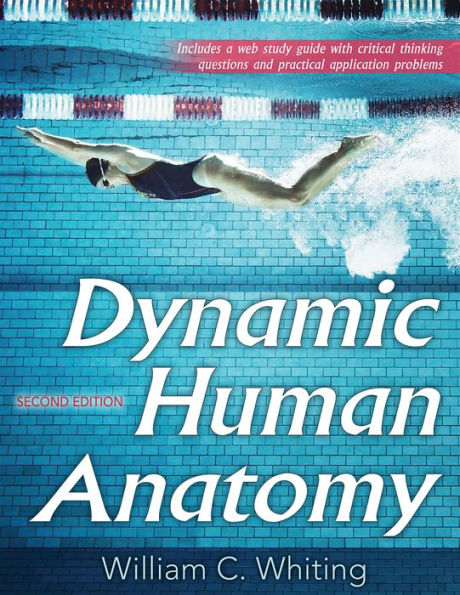Dynamic Human Anatomy, Third Edition With HKPropel Access, covers concepts not found in traditional anatomy texts. It sets itself apart by linking anatomy to biomechanics principles to explain fundamental movements and movement patterns. With a greater understanding of anatomy in conjunction with how the body moves, students planning for a career in any field of human movement—including those pursuing preclinical degrees—will be better prepared to assess muscle action and employ specific movement applications.
The third edition of Dynamic Human Anatomy provides students with an understanding of the body’s structure as it explores the complexity of the body’s functional movement anatomy. Unlike many titles that focus primarily on sport mechanics, this text also offers supporting information on everyday body motions.
New to This Edition
- Addition of bony landmarks plus images for understanding muscle attachment points
- Expanded information on osteoporosis beyond postmenopausal women, including gymnasts and ballet dancers
- Added exploration of musculotendinous sensory structures and their role in reflexes
- New information on sleeping surfaces and postures for lying down
- Discussion of muscle adaptations as a result of resistance and endurance training
- New section on cycling, including pedaling cycle, propulsion, cadence, body position, and aerodynamic drag
Dynamic Human Anatomy also offers a full-color design with over 300 illustrations and photos to visually represent the concepts. Learning aids include a glossary, chapter objectives, summaries, and suggested readings. Applying the Concept sidebars offer practical examples of real-world scenarios. Numerous tables provide quick summaries of muscles and actions, joint structure and movements, exercises for specific muscle groups, and developmental reflexes. The tables are also available online as downloadable resources, along with critical thinking questions, delivered through HKPropel.
The third edition of Dynamic Human Anatomy is sensibly organized with a progressive approach. It opens with the general concepts of human anatomy and the structure and organization of the skeletal system. The second part discusses biomechanical properties essential to understanding and assessing human movement, including the muscle control formula.
The text then connects structural anatomy with biomechanics to focus on everyday movements and movement patterns. Students will examine posture and balance, gait, and other functional movements like jumping and lifting. The final section explores further applications for strength and conditioning, sport and dance, clinical scenarios, and ergonomics.
Dynamic Human Anatomy, Third Edition With HKPropel Access, explores the potential of the human body to express itself through movement, making it a highly valuable text for students who need a more detailed exposure to concepts in human movement anatomy.
Note: A code for accessing HKPropel is included with all print books.
Dynamic Human Anatomy, Third Edition With HKPropel Access, covers concepts not found in traditional anatomy texts. It sets itself apart by linking anatomy to biomechanics principles to explain fundamental movements and movement patterns. With a greater understanding of anatomy in conjunction with how the body moves, students planning for a career in any field of human movement—including those pursuing preclinical degrees—will be better prepared to assess muscle action and employ specific movement applications.
The third edition of Dynamic Human Anatomy provides students with an understanding of the body’s structure as it explores the complexity of the body’s functional movement anatomy. Unlike many titles that focus primarily on sport mechanics, this text also offers supporting information on everyday body motions.
New to This Edition
- Addition of bony landmarks plus images for understanding muscle attachment points
- Expanded information on osteoporosis beyond postmenopausal women, including gymnasts and ballet dancers
- Added exploration of musculotendinous sensory structures and their role in reflexes
- New information on sleeping surfaces and postures for lying down
- Discussion of muscle adaptations as a result of resistance and endurance training
- New section on cycling, including pedaling cycle, propulsion, cadence, body position, and aerodynamic drag
Dynamic Human Anatomy also offers a full-color design with over 300 illustrations and photos to visually represent the concepts. Learning aids include a glossary, chapter objectives, summaries, and suggested readings. Applying the Concept sidebars offer practical examples of real-world scenarios. Numerous tables provide quick summaries of muscles and actions, joint structure and movements, exercises for specific muscle groups, and developmental reflexes. The tables are also available online as downloadable resources, along with critical thinking questions, delivered through HKPropel.
The third edition of Dynamic Human Anatomy is sensibly organized with a progressive approach. It opens with the general concepts of human anatomy and the structure and organization of the skeletal system. The second part discusses biomechanical properties essential to understanding and assessing human movement, including the muscle control formula.
The text then connects structural anatomy with biomechanics to focus on everyday movements and movement patterns. Students will examine posture and balance, gait, and other functional movements like jumping and lifting. The final section explores further applications for strength and conditioning, sport and dance, clinical scenarios, and ergonomics.
Dynamic Human Anatomy, Third Edition With HKPropel Access, explores the potential of the human body to express itself through movement, making it a highly valuable text for students who need a more detailed exposure to concepts in human movement anatomy.
Note: A code for accessing HKPropel is included with all print books.

Dynamic Human Anatomy
336
Dynamic Human Anatomy
336eBook (Second Edition)
Related collections and offers

Product Details
| ISBN-13: | 9781492588689 |
|---|---|
| Publisher: | Human Kinetics Publishers |
| Publication date: | 11/07/2018 |
| Sold by: | Barnes & Noble |
| Format: | eBook |
| Pages: | 336 |
| File size: | 105 MB |
| Note: | This product may take a few minutes to download. |
| Age Range: | 18 Years |
